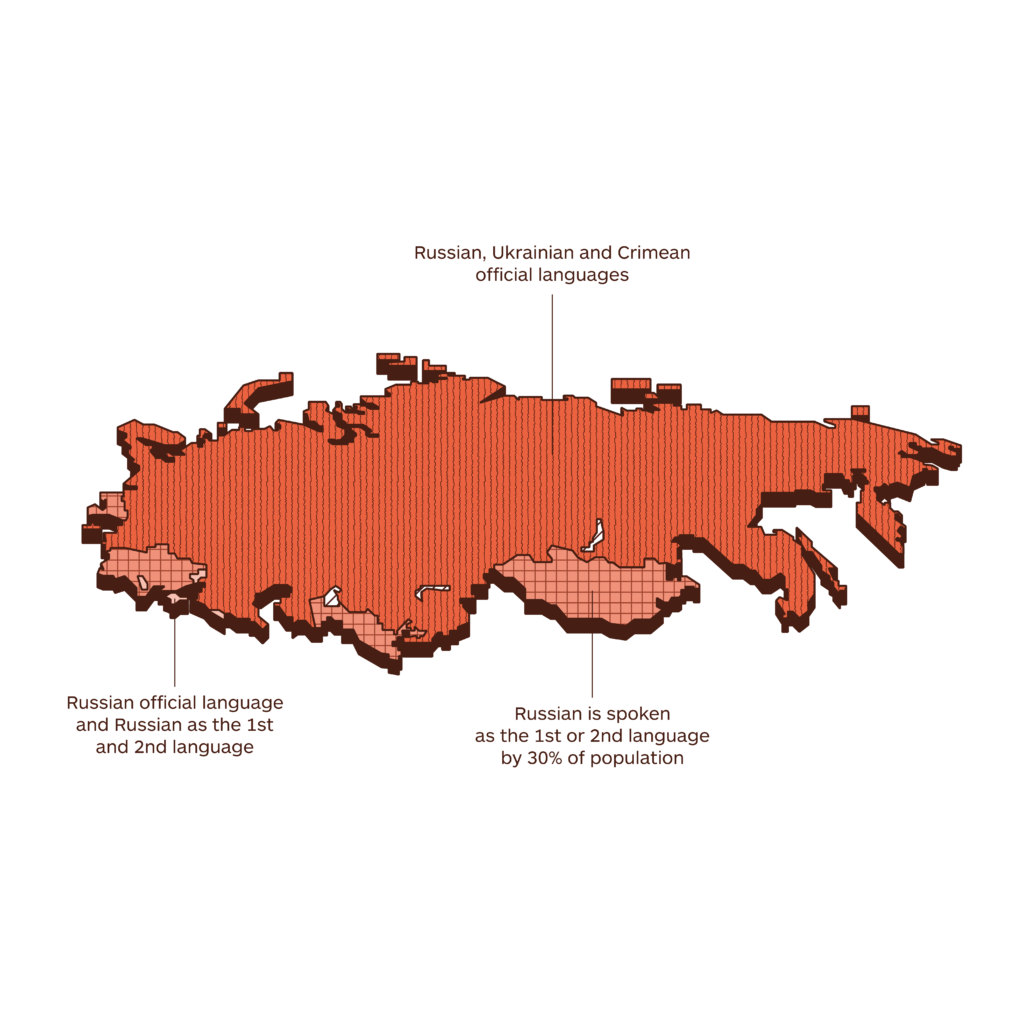Europe
To which language should you translate to localize in Russia?
What we know from our community
Russian is the language of the East Slavic group of the Slavic branch of the Indo-European family of languages. It is the sixth most widely spoken language in the world.
Although there are many different ethnic groups with their own languages in Russia, their degree of penetration in everyday life is minimal. A resident of the westernmost point, Kaliningrad, will easily understand a resident of the easternmost point, Vladivostok as well as any other person whose native language is Russian. The vast majority of differences will be noticeable only in speech and only to a trained ear. There are also some local peculiarities: mainly concerning everyday objects, food, and sometimes natural phenomena.
In addition to Russia, Russian is spoken in nearby countries that were formerly part of the USSR. There are also large Russian-speaking diasporas in the United States, Israel, and Germany – we are talking about several million people.
Some inflexibility of the Russian language in the borrowings and formation of new forms of words is compensated by a large number of synonyms and figurative means. Moreover, since in the Russian language, the order of words in a sentence is arbitrary, there is quite a lot of room for creativity.
Introduction
Language
Official language
Russian
T-index
1.6%
T-Index ranks countries according to their potential for online sales.
Other languages
Minority languages: Ossetic, Ukrainian, Buryat, Kalmyk, Chechen, Ingush, Abaza, Adyghe, Cherkess, Kabardian, Altai, Bashkir, Chuvash, Crimean Tatar, Karachay-Balkar, Khakas, Nogai, Tatar, Tuvan, Yakut, Erzya, Komi, Hill Mari, Meadow Mari, Moksha and Udmurt
Foreign languages: English, German, French, Turkish and Ukrainian
Most studied languages English (92%), German (17%), Chinese (15%), and French (10%)
English
Moderate proficiency (EF) – 51st out of 112 countries/regions in the world- 32/35 position in Europe.
Demography
Capital: Moscow
Currency: Russian Rouble
Population: 143,45 million
Population density: 9/km2
Economy
GDP: 1,775,799.92 trillion USD (2020)
GDP per capita: 12,172.8USD (2020)
Exports: $330 billion (2020)
Statistics
Internet users: 89% penetration, 129.8 million
Unemployment rate: 5.6% (2020)
Urbanisation: 74.43% (2018)
Literacy: 99.68% (2018)
Conventions
Numbering system
Arabic numerals and comma as decimal separator
Date format: yyyy-mm-dd/dd-mm-yyyy
Time: 24h time system
Country code: 007
Language data sources: Worldatlas/Britannica//EF/Wikipedia; Demography data sources: IMF/Worldometers; Conventions data source: Wikipedia; Economy data sources: WTO/OEC/CIA/Esomar/Datareportal; Statistics data sources: Datareportal/WorldBank/UN/UNESCO/CEIC/IMF/Culturalatlas/Commisceoglobal
Facts and data
Economy
Imports
$220 billion (2020). Cars ($7.75B), Vehicle Parts ($7.28B), Broadcasting Equipment ($7.15B), Packaged Medicaments ($7.06B), and Computers ($4.1B), importing mostly from China ($50.7B), Germany ($26.1B), Belarus ($12.8B), South Korea ($7.93B), and Italy ($7.71B).
Financial inclusion factors (over 15 years of age)
• 76% have an account with a financial institution
• 20% have a credit card
• 40% make online purchases
Ease of doing business
It is very easy to conduct business (rated 78.2 out of 100) ranked 5th out of 44 countries in Europe and Central Asia, ranked 28th out of 190 countries worldwide (2019, World Bank)
Exports
$330 billion (2020). Crude Petroleum ($74.4B), Refined Petroleum ($48B), Petroleum Gas ($19.7B), Gold ($18.7B), and Coal Briquettes ($14.5B), exporting mostly to China ($49.3B), United Kingdom ($25.3B), Netherlands ($22.5B), Belarus ($15.8B), and Germany ($14.2B).
Main local online stores
Aliexpress.ru, Ozon.ru, Eldorado.ru, Dns-shop.ru, Mvideo.ru, Wildberries.ru, Ulmart.ru, eBay.ru, Lamoda.ru and Citilink.ru.
Economic freedom
‘Mostly not free’ (56.1 out of 100) ranked 43rd out of 45 European countries ranked 113rd out of 186 countries worldwide (2019, Heritage Foundation and Wall Street Journal)
Global Innovation Index
Ranked 29th out of 39 European countries, 45th out of 132 worldwide.
The Global Innovation Index captures the innovation
ecosystem performance of 132 economies and tracks the most recent global innovation trends.
Economy data sources: WTO/OEC/CIA/Esomar/Datareportal
Service imports (2018)
Source: OEC
Service exports (2018)
Source: OEC
Most complex products by PCI Index
Product Complexity Index measures the knowledge intensity of a product by considering the knowledge intensity of its exporters
Source: OEC
Most specialised products by RCA Index
Specialisation is measured using Revealed Comparative Advantage, an index that takes the ratio between Russia observed and expected exports in each product
Source: OEC
Export by Relatedness Opportunity
Relatedness measures the distance between a country's current exports and each product, the barchart show only products that Russia is not specialized in
Source: OEC
Total distribution of payment methods in Russia in 2018
Sources: Worldpay; Paypers

T-index
Reach most of the online purchasing power
T-Index ranks countries according to their potential for online sales. It estimates the market share of each country in relation to global e-commerce.
Try it nowMedia
Media language English, Russian
Information channels
Television is the most powerful sector of the media industry and the main news source for most Russians, although its dominance is being eroded by the internet. The top national TV networks are either state-run or owned by companies with close links to the Kremlin. The government controls Channel One and Rossiya 1 – the leading channels – while state-run energy giant Gazprom owns NTV. The thriving pay-TV market is led by the satellite platform Tricolor. A project to bring digital TV to every Russian home is close to completion, although some analogue transmissions continue. RT, launched in 2005 as the state-funded English-language TV station Russia Today, is the flagship of Russia’s international media operations. It has launched TV networks in Arabic, Spanish and French. Since the Ukraine crisis, Russian state media have intensified the pro-Kremlin and nationalistic tone of their broadcasts, broadcasting a regular diet of adulation for Mr Putin, nationalistic pathos, fierce rejection of Western influence and attacks on the Kremlin’s enemies. Some observers have accused pro-Kremlin TV of spreading disinformation and conducting an information war both at home and abroad. There are more than 3,000 licensed radio stations. The three main state networks Radio Rossii, Mayak and Vesti FM compete with music-based commercial stations. Of the 18,000 registered newspapers, 20 can be described as national titles. The most popular papers are pro-Kremlin and several influential dailies are owned by companies with close links to the Kremlin.
Television
Rossiya 1 – national network, run by state-owned Russian State Television and Radio Broadcasting Company (VGTRK)
Channel One – national network, 51% owned by state, 49% by private shareholders
NTV – national network, owned by state-run Gazprom
Centre TV – owned by Moscow city government
Ren TV – Moscow-based commercial station with strong regional network, majority-owned by media holding NMG
RT – state-funded, international English-language news channel, via satellite
Radio
Radio Rossii – national network run by state-owned Russian State Television and Radio Broadcasting Company (VGTRK)
Vesti FM – state-owned, news and talk
Ekho Moskvy – editorially-independent, majority owned by state-run Gazprom
Radio Mayak – state-run national network
Russkoye Radio – major private network, music-based
Sputnik – state-run external multimedia platform; offers radio broadcasts in some 30 languages
Risks
Russian journalists run the risk of attack and even murder if they delve too deeply into sensitive subjects such as corruption, organised crime or rights abuses. Russia is a regular target for criticism and condemnation from media freedom watch dogs. A 2016 law caps foreign ownership of media outlets at 20%. Some foreign companies have either quit the market or else ceded majority control of their Russian operations to local partners. The total number of internet users in Russia aged over 12 was 95 million in 2019, equating to more than 78% of the population, according to state-owned audience researcher Mediascope. While the internet is less tightly controlled than traditional media, the Kremlin has made moves to restrict online freedoms. Laws allow the authorities to block websites without explanation, require popular bloggers to register with the mass media regulator Roskomnadzor and demand that internet companies give the authorities access to users’ information. Internet users have increasingly found themselves the target of criminal prosecutions for their online activity, sometimes resulting in prison terms. The authorities are keen to curb the influence of major international internet companies. The so-called Sovereign Internet Law, which came into effect in November 2019, paves the way for making the Russian internet an autonomous entity separate from the World Wide Web. Two companies stand out on the internet market in Russia: Yandex, which runs the top search engine; and the Mail.ru Group, which owns two of the most popular social networks, VKontakte and Odnoklassniki.
The press
Komsomolskaya Pravda – mass circulation, pro-Kremlin tabloid
Kommersant – daily, business-orientated, controlled by steel tycoon Alisher Usmanov
Moskovsky Komsomolets – popular privately-owned Moscow daily
Izvestia – popular pro-Kremlin daily, owned by media holding NMG
Rossiyskaya Gazeta – government-owned daily
Nezavisimaya Gazeta – influential privately-owned daily
Argumenty i Fakty – popular weekly, owned by Promsvyazbank
Novaya Gazeta – publishes three times a week, known for its investigative journalism
RBC – business daily
Vedomosti – financial daily
News agency
TASS – state-owned news agency, pages in English
Interfax – private news agency, pages in English
Lenta.ru – popular online news source
The Moscow Times – English-language news site, successor to now defunct newspaper
Rambler.ru – major portal
Sputnik – state-run international-facing multimedia platform; services in many languages
Yandex.ru – leading search engine
VKontakte – leading social network
Media data source: BBC
Internet Data
internet users
89% penetration, 129.8 million
Share of web traffic by device
34.62% mobile phones, 64.17% computers (laptops and desktops), 1.20% tablet devices, others 0.01%
Median speed of mobile Internet connection
17.84 Mbps
Median speed of fixed Internet connection
61.65 Mbps
Mobile connection as a percentage of total population: 155.8%
Percentage of mobile connections that are broadband (3G-5G): 84.1%
Most popular web search engines
Google (94.46%), Bing (2.99%),Ecosia (0.66%), Yahoo (0.59%), Duckduckgo (0.58%), t-online (0.25%)
Most used social media
Instagram (18.44%), Twitter (17.42%), Vkontakte (17%), Pinterest (15.64%), Facebook (15.19%), YouTube (13.45%)
Internet data sources: Datareportal/Statcounter
Average time spent on using internet in Russia per day in December 2019, by device category and age group
Source: Mediascope
Ranking of 10 best mobile applications in Russia in 2019
Sources: rusbase.com; Banki.ru; Go Mobile
Number of monthly active users of messengers in Russia in December 2019, by application (in millions)
Sources: Mediascope; RMAA Groupe
Gender distribution of social media users in Russia as of November 2019, by platform
Source: Brand Analytics
Social statistics
Life expectancy
72.12 yrs (2017)
Average age of the population
39.6 yrs (2020)
Urbanisation
74.43%
Healthcare expenditure
11.5% of GDP (2018)
Graduates (tertiary education)
The Russian Federation has one of the highest tertiary attainment rates across OECD countries, at 63% of 25-34 year-olds compared with the OECD average of 44% (2019)
Social statistics sources: WorldBank/UN/UNESCO/CEIC/IMF
Index rating of medical tourism in Russia in 2016, by criteria
Source: The International Healthcare Research Center
Market volume of online education in Russia in 2016 with a forecast until 2021, by educational level
(in billion Russian rubles)
Source: Kommersat; Netology; Higher School of Economics; comScore; FOM
The Data Factbook is a work in progress project. Our community is helping us to fill it up always with new and updated data. Your contribution is precious. If you want to help us, please write your advices at imminent@translated.com
Languages research
Languages spoken in Russia

Legend
-
Russian,Ukrainian and Crimean
-
Russian is spoken as the 1st or 2nd language by 30% of population
-
Russian official language and Russian as the 1st and 2nd language
-
Uninhabited
The geographical distribution of languages that you will find in the maps published in this section is a work in progress. Our community is helping us to fill it up with always new and updated data. Your contribution is precious. If you want to help us, please write to imminent.factbook@translated.com
Photo credit: David Torres, Unsplash
